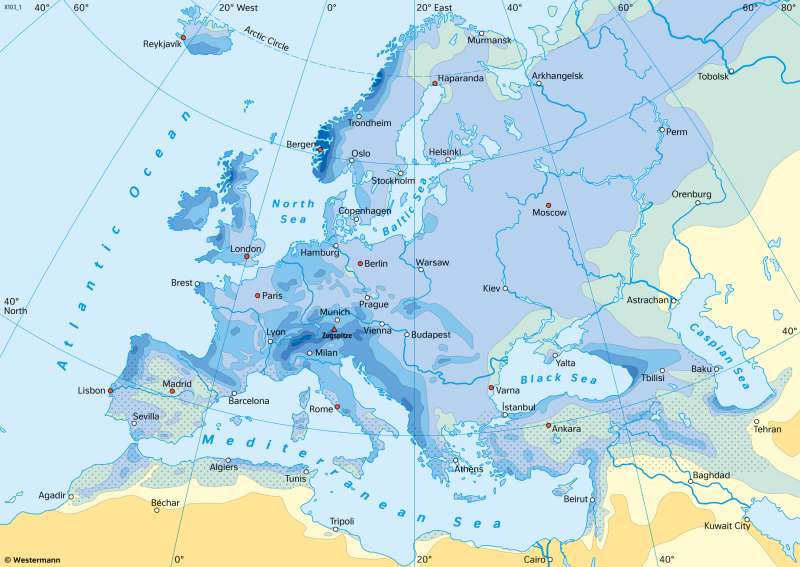Europe - Annual precipitation
Climate
978-3-14-100890-6 | Page 53 | Ill. 4

Overview
Europe's precipitation distribution is influenced by the topography. In addition to altitude, windward and leeward effects also play an important role.
Cyclonal and thermic precipitation
A large part of the precipitation in Europe falls from migrating low-pressure vortices, predominantly with the direction of migration from west to east. Since the lifetime of these "wandering cyclones" is usually only a few days, the precipitation over Europe associated with them gradually decreases from west to east. This results in a gradient of precipitation distribution from the western edge to the interior of the continent. In addition, an increasing annual cycle of precipitation with a summer rainfall maximum occurs towards the east, which is also referred to as hygric continentality. The increased precipitation activity in summer results from the strong warming of the continental masses in the interior of the continent. This leads to vertical air movements and convective cloud cover with corresponding precipitation.
Seasonality of the air pressure systems
The westerly high-altitude current, under which the low-pressure vortices develop and in whose west-east circulation they are integrated, shifts during the course of the year. The paths along which the "wandering cyclones" are transported to Europe change accordingly. In summer, a wedge of subtropical high pressure over the Azores deflects the low-pressure areas over Europe to the north and thus keeps them away from the Mediterranean region. In winter, on the other hand, the westerly wind jet is shifted to the south and now also steers Atlantic lows into the Mediterranean area. In addition, independent low-pressure vortices develop over the relatively warm Mediterranean area, for example over the Golfe du Lion or the Gulf of Genoa. For this reason, precipitation around the Mediterranean falls mainly in the winter.
Orographic precipitation
In addition to the west-east gradient of the precipitation distribution in Europe, a change in the altitude of the precipitation amounts can be clearly recognised. Precipitation generally increases with increasing altitude. The reason for this is both congestion effects and the higher wind speeds in the mountain regions, which accelerate the supply of moist air masses. A north-south orientation of the mountain ranges further intensifies this effect due to the prevailing westerly winds at altitude. This is particularly evident on the western slope of the Scandinavian Mountains (cf. climate diagram Bergen). In the lee of such mountains, precipitation decreases considerably due to foehn effects, such as in the highlands of Spain.




